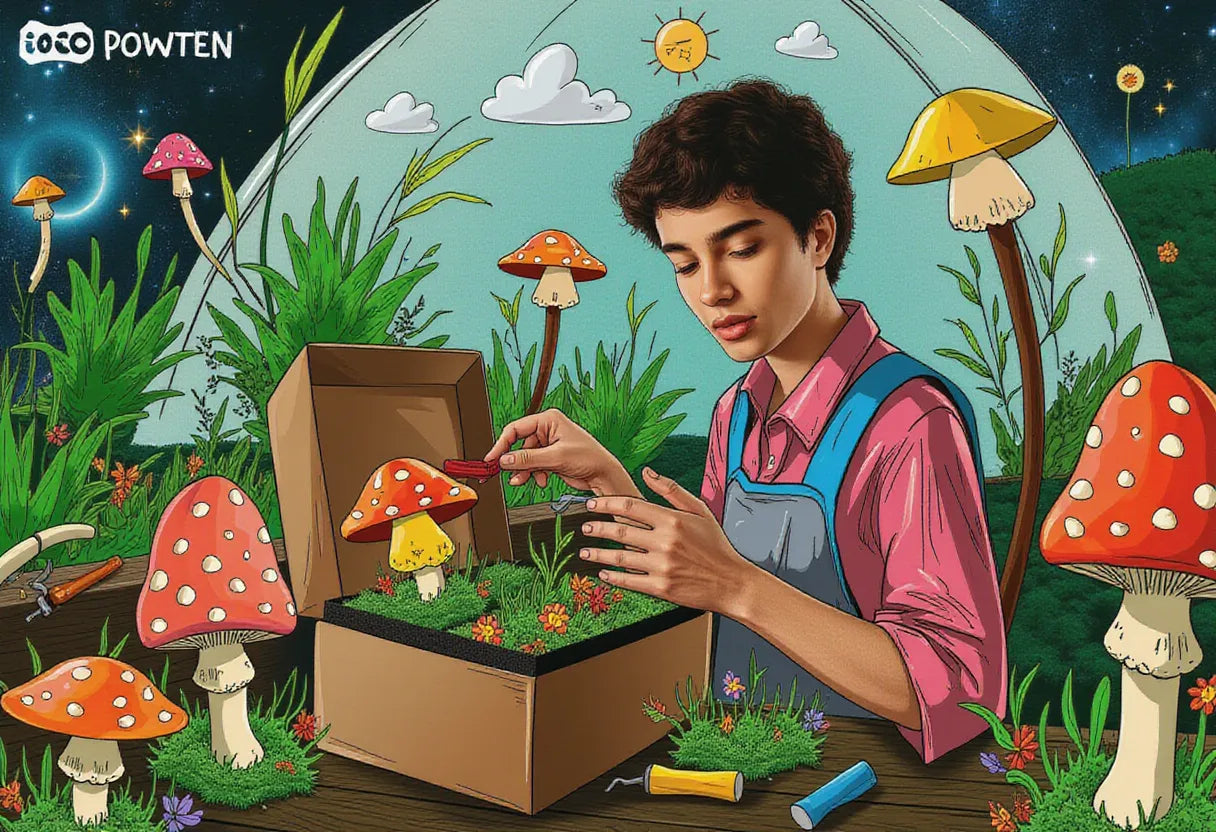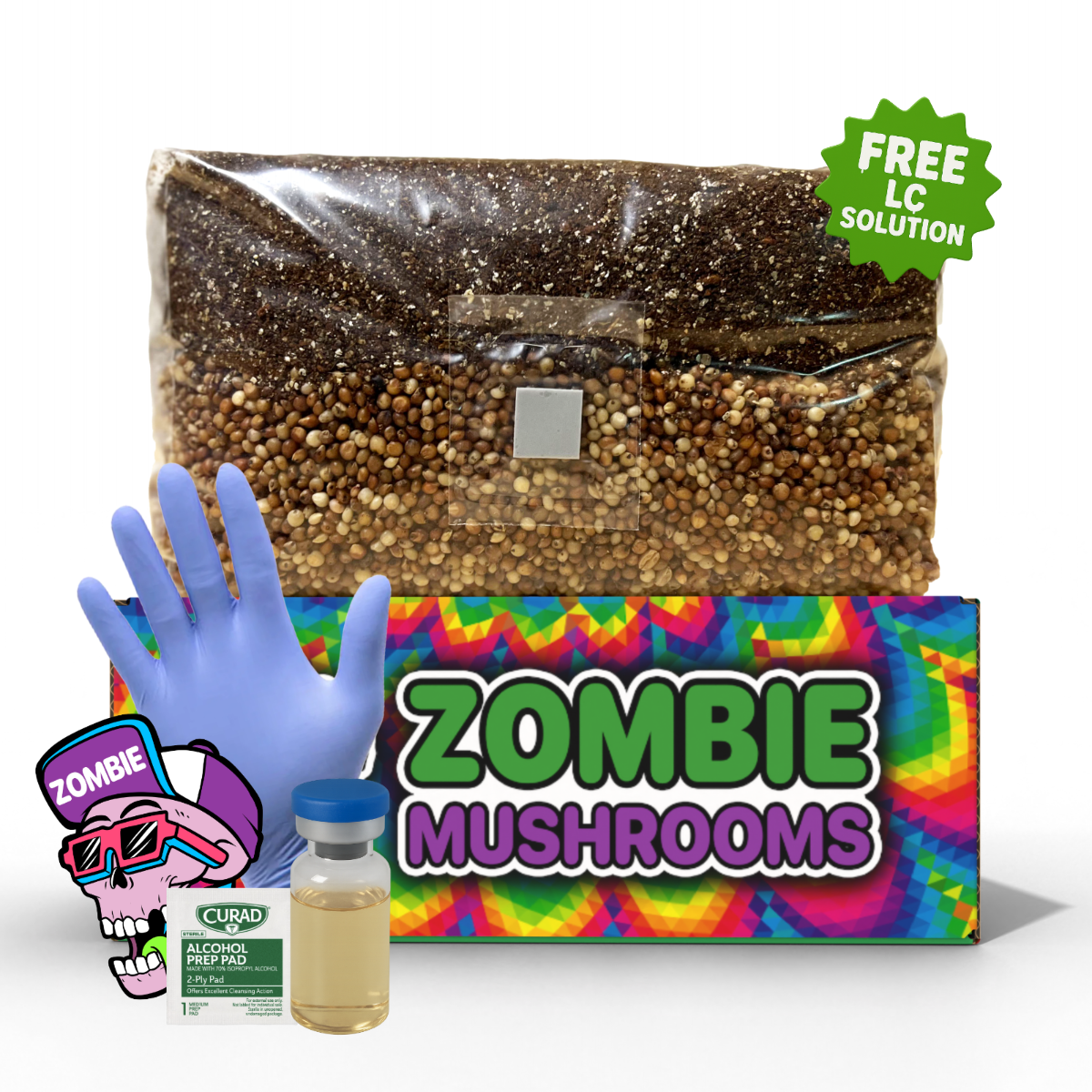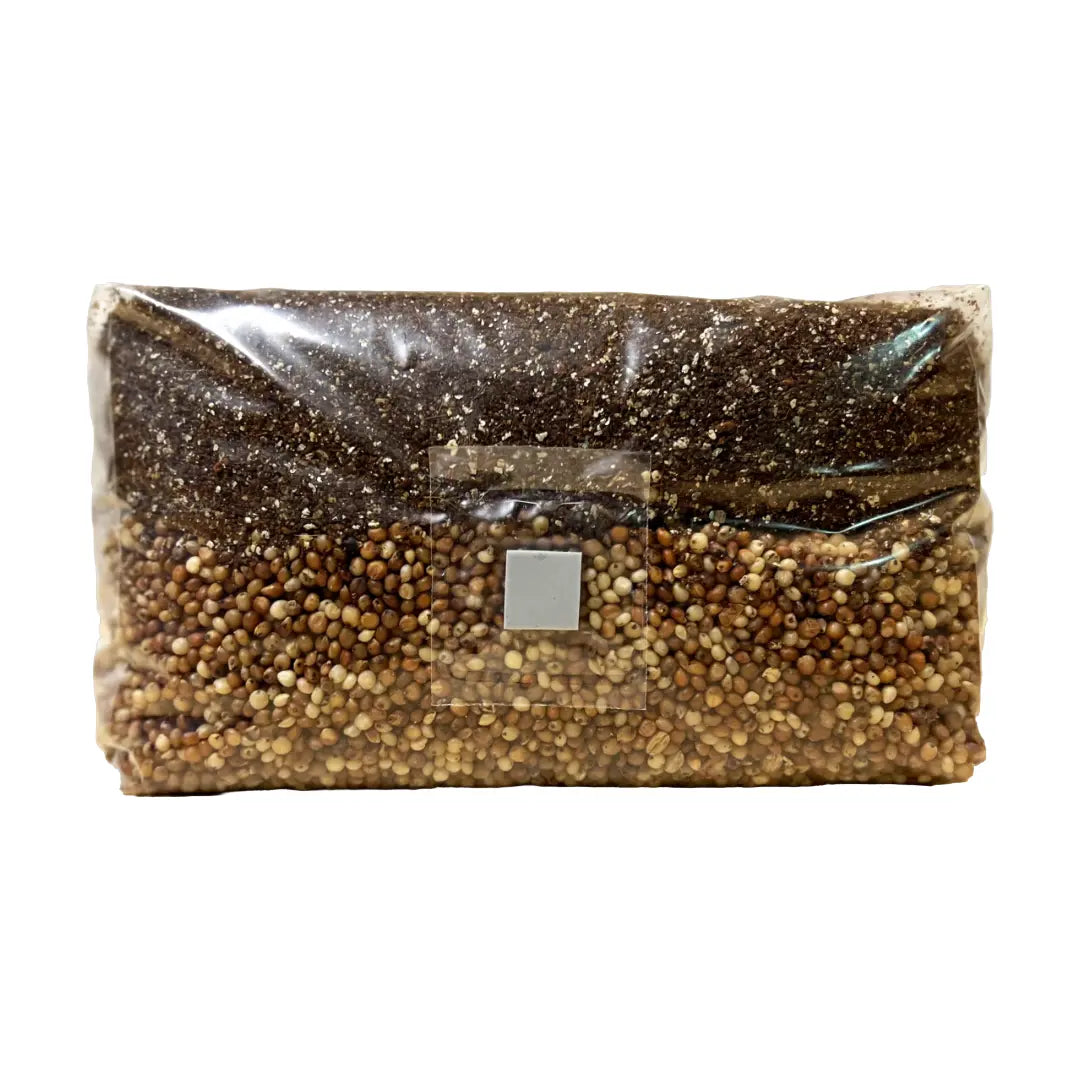⬇️ Prefer to listen instead? ⬇️

- Commercial mushrooms grow in sterile, controlled environments using no actual soil or manure.
- The "dirt" on mushrooms is peat moss, part of a hygienic casing layer used in controlled cultivation.
- Sterilization processes heat mushroom grow rooms to 160°F (71°C) to eliminate bacteria and pests.
- Mushroom substrate is pasteurized—not sterilized—to maintain beneficial organisms while ensuring safety.
- Peat-based casing layers are safe, clean, and never come into contact with raw compost or pathogenic materials.
Have you ever seen tiny specks on mushrooms and wondered if “mushroom dirt” means danger? Rest assured, most of what you see isn’t soil or manure—it’s harmless casing materials like peat moss, coco coir, or vermiculite used during cultivation. These materials help maintain humidity and structure without introducing pathogens. For home growers, clean tools and reliable setups like mushroom grow kits or mushroom grow bags ensure safety and minimize residue. In this article, we’ll explain what mushroom dirt really is, how mushrooms are grown, and why those specks don’t make them unsafe to eat.

Busting the Myth: What Is Mushroom “Dirt” Actually?
Mushroom “dirt” isn’t garden soil—it’s usually organic casing materials like peat moss, vermiculite, or composted coir, added above the substrate to help with fruiting. This casing conserves moisture, triggers mushroom pinning, and gently shapes mushrooms as they grow.
Since these materials are processed and sanitized, they are generally free of harmful microbes. The specks you see clinging to mushroom caps or stems are not dirt in the typical sense, and they pose little risk when cleaned properly.
Understanding that these particles come from peat moss, not outdoor soil or manure, helps dispel myths about mushrooms being “dirty” or unsafe due to surface specks. In fact, modern commercial mushroom farming is one of the most sanitary horticultural operations in existence.
Understanding Mushroom Cultivation
How Mushrooms Are Grown: A Controlled Environment
Mushrooms may look wild, but their commercial cultivation is anything but. Clean, controlled growing environments have become the standard for large-scale mushroom farming.
Mushrooms grow indoors in specially designed growing rooms, often stacked in towering shelves or in long trays. These spaces are sealed from environmental contaminants such as outdoor soil, animals, bacteria, and rainfall, which are common in typical crop farming. This level of control allows growers to ensure food safety and quality at every stage.
Typically, mushrooms like white button, crimini, and portobello ones are raised on
- Compost-based or straw-based substrate beds
- Carefully regulated lighting (or darkness, depending on the species)
- Monitored temperature ranging between 55-65°F (13-18°C)
- Humidity levels hovering around 90%
- Constant oxygen exchange and carbon dioxide control
Even specialty or gourmet mushroom varieties such as oyster, lion’s mane, or shiitake follow similar principles for cleanliness and sustainability.
Sanitization & Sterility: Laying the Foundation for Safety
Before mushroom cultivation even begins, growers prioritize hygiene to reduce the risk of contamination. The first step is sterilizing the grow room with industrial methods.
The entire grow area, including tools and surfaces, is heated to approximately 160°F (71°C) for a full 24 hours. This level of heat effectively destroys
Why is this high-level sanitization necessary? It eliminates any competition that could interfere with healthy mushroom growth and ensures that mushrooms develop without compromise.
Unlike vegetables or fruits that grow in open-air farms exposed to birds, animals, fertilizers, and weather, mushrooms thrive in an environment managed down to the microscopic detail.

The Role of Substrate in Mushroom Growth
What Is Mushroom Substrate?
Mushrooms grow from organic material called substrate, which acts like both soil and fertilizer—except this "soil" is man-made and intentionally sterile.
Common substrate components include
- Straw and hay
- Wood chips
- Corn cobs
- Coco coir
- Composted agricultural waste
The ingredients vary depending on the type of mushroom being grown, but all substrates are processed to remove pathogens while preserving beneficial decomposers.
Pasteurization vs. Sterilization
The substrate is pasteurized—not sterilized—at around 136°F (58°C) for eight hours. Pasteurization allows certain favorable microorganisms to survive, helping make a good place for mushrooms to grow. This differs from sterilization, which wipes out nearly every form of life.
This pasteurization process helps eliminate unwanted bacteria and pests without disrupting the necessary balance fungi need to thrive.
Introduction to Mushroom Spawn
After pasteurization, the substrate is inoculated with mushroom spawn. Spawn refers to live mycelium, the vegetative part of a fungus, usually grown on sterilized cereal grains such as
These grains act as carriers for the mycelium and help it spread efficiently throughout the substrate. Mushroom spawn is typically produced in very clean lab conditions to ensure that no mold, bacteria, or rogue fungi contaminate the medium.
Once introduced into the substrate, the mycelium begins spreading through it over several days, spreading like a web until it's ready to support the development of fruiting bodies—the mushrooms we harvest and eat.

Peat Moss and the Casing Layer
Why Peat Moss?
Once the mycelium has spread all through it, a 2-inch casing layer of moist peat moss is added over the colonized substrate. This is where the so-called “mushroom dirt” originates.
Peat moss serves several vital purposes, including
- Retaining surface humidity
- Triggering fruiting by signaling environmental change
- Supporting mushroom cap shaping during growth
Unlike nutrient-rich substrate beneath, casing is non-nutritive. It doesn’t feed the mushrooms directly but plays an essential role in fruit development.
As mushrooms push upward through this peat moss casing, fine particles often cling to the stems and caps. These are completely safe to ingest, as they come from a carefully sourced and sanitized horticultural medium.

Environmental Controls and Fruiting
Mushrooms respond to environmental cues to know when it's time to produce fruiting bodies. In commercial grow rooms, farmers adjust conditions like
- Oxygen levels
- Carbon dioxide concentrations
- Temperature
- Light exposure
- Humidity
Once the ideal range is achieved for a particular species, the mycelium responds by fruiting—developing mushrooms.
The first mushroom “flush” is usually visible about 15 days after casing. Some farms harvest multiple flushes from a single substrate batch by readjusting the environment.

Harvest Time: What Ends Up on the Mushroom?
Mushrooms are typically harvested by hand to prevent bruising and to selectively pick the healthiest specimens. Workers gently twist or cut mushrooms at the base, often leaving behind casing particles.
As these mushrooms emerge through the peat moss casing, they come into contact with the fibrous medium—hence the fine specks on store-bought mushrooms. Unlike crops grown in soil, there are no rocks, clumps of earth, or bugs.
This is why even unwashed mushrooms are generally safer than most raw produce when it comes to microbial load.

Are Mushrooms Grown in Manure?
This is perhaps the most persistent myth in mushroom cultivation.
While it’s true that some mushroom substrates may include composted manure as one component, the substance used is not raw manure. It goes through a rigorous composting process followed by pasteurization. This means
- All harmful microorganisms (E. coli, Salmonella, etc.) are destroyed
- Beneficial decomposers remain
- Final substrate is safe, balanced, and optimized for growth
Moreover, the casing layer—the only material mushrooms actually grow through and touch—is never made from manure. It’s 100% peat moss, ensuring the edible portion of the crop never contacts composted materials at all.

How to Clean Mushrooms Safely
-
Use a colander or fine sieve and rinse mushrooms quickly under cold running water—avoid soaking them.
-
Lightly brush or rub off visible casing specks with clean hands or a soft brush.
-
Pat them dry with a clean towel.
-
Important: Avoid letting mushrooms sit in water, or storing them wet, as this can lead to soggy texture or surface spoilage.
These steps preserve flavor and texture while keeping your mushrooms safe.

Are Mushrooms Safe to Eat with “Dirt” on Them?
Yes—mushrooms are absolutely safe to eat with casing particles attached, especially if they're commercially grown.
Due to
- Indoor cultivation
- Pasteurized or sterilized growth mediums
- Lab-sealed spawn
- Peat moss casing
- Manual harvesting
mushrooms from reputable producers pose minimal risk and are cleaner than many other produce items.
You can safely cook mushrooms with a few casing flecks still in place. Doing so won’t harm you and won't noticeably affect taste or texture, particularly when sautéed or roasted.
Mushroom Safety Tips for Home Growers
If you're using a mushroom grow kit at home, both safety and sanitation still apply. Follow these best practices for safe cultivation
- Wash your hands before handling anything
- Use sterilized tools (boiled or alcohol-wiped)
- Keep pets and outside debris away from your grow area
- Maintain good airflow, but avoid drafts or open windows
- Always buy spawn or substrate from accredited suppliers
Kits from producers like Zombie Mushrooms provide pre-pasteurized, lab-sealed materials for safe and stress-free home growing.

The Bigger Picture: Clean Growing for a Healthier Consumer
Mushroom cultivation is not only clean—it’s one of the most good for the environment and works very well systems in agriculture. Compared to other crops, mushrooms
- Require less water
- Produce minimal agricultural runoff
- Grow in vertical systems, saving space
- Rely on upcycled agricultural waste
And because they're grown indoors, mushrooms are less prone to pesticide use, harsh weather, and soil degradation. This makes them one of the most responsible and safe choices in your produce aisle.
FAQ
-
Is mushroom casing material like peat moss safe to eat if it stays on the mushroom?
Yes. Casing materials like peat moss are processed and sanitized, making small residual specks safe. -
Does mushroom “dirt” make mushrooms less healthy?
No—those specks don’t affect nutritional value. The edible flesh comes from the fruit body and remains good even if some casing particles cling on. -
Can casing materials carry harmful microbes?
If sourcing is reputable—yes, risk is very low. Pasteurized or lab-processed casing materials are standard in modern cultivation. -
Do I need to wash mushrooms if they have casing specks?
It's not strictly necessary, but rinsing or brushing before cooking is helpful for aesthetics and eating comfort. -
How does growing environment affect safety of “mushroom dirt”?
Clean cultivation practices (sterile tools, quality spawn, sanitized substrates, filtered airflow) reduce contaminants. Home grow kits often include already processed casing, reducing risk further.
Don’t Fear the “Dirt”
When you see specks on mushrooms, know that you're looking at incredibly clean, lab-like ways of growing things—not filth. That speckled coating isn’t “dirt” at all—it’s peat moss, an essential part of a controlled growing system designed for safety and quality.
Armed with this knowledge about how mushrooms are grown, the role of mushroom dirt, and basic mushroom safety, you can cook and eat with confidence and even grow your own mushrooms at home.
Ready to grow your own mushrooms safely at home? Shop our lab-sealed mushroom grow kits and sterile spawn from Zombie Mushrooms to get started today.



